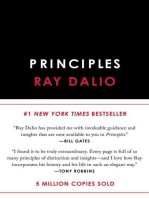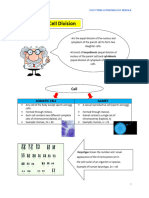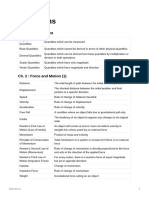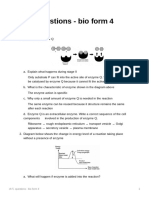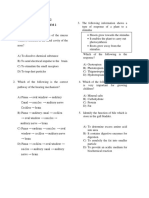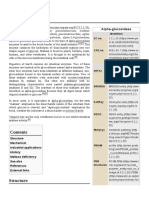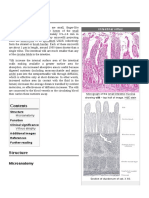$RVEIMSE
$RVEIMSE
Uploaded by
Crow LordCopyright:
Available Formats
$RVEIMSE
$RVEIMSE
Uploaded by
Crow LordCopyright
Available Formats
Share this document
Did you find this document useful?
Is this content inappropriate?
Copyright:
Available Formats
$RVEIMSE
$RVEIMSE
Uploaded by
Crow LordCopyright:
Available Formats
Daffodils - Line by Line Analysis
Stanza 1:
I wandered lonely as a cloud
That floats on high o'er vales and hills,
When all at once I saw a crowd,
A host, of golden daffodils;
Beside the lake, beneath the trees,
Fluttering and dancing in the breeze.
The poet was travelling aimlessly just like a cloud over the hills and valleys of the mountainous Lake
District in England. At that time, suddenly he came across a large number of golden daffodils beside the
lake and under the trees. The flowers were ‘fluttering and dancing’ in the breeze.
The poet directly compares himself to a cloud, as he was wandering without aim, just like the clouds. This
is an example of simile (Simile is a figure of speech where two things are compared using ‘as’ or ‘like’.
Read more about figures of speech). He also uses the expressions like ‘crowd’ and ‘host’ to mean that he
saw a large area covered with a whole lot of daffodils. In the last line, the poet personifies the flowers by
saying that they were fluttering (like birds or butterflies) and dancing (like human beings). There is also
an indication that it was a breezy day. So we get an overall idea of the landscape which includes the
valleys and hills, the lake, the trees, the flowers beneath them and the breezy atmosphere.
In the first stanza of ‘I Wandered Lonely as a Cloud,’ Wordsworth explains his one-day occasional aimless
wandering. The term “wandered” means walking free of their own accord. The poet is referring to himself
as the “cloud” in a metaphorical sense of the word. Although the clouds mostly travel in groups, this cloud
prefers singular hovering. However, he clearly mentions his passing through valleys and hills on a routine
walk, simplifying the narrative.
The poet comes across a bunch of daffodils fluttering in the air. He’s dumbfounded by the beauty of those
“golden daffodils.” Although yellow would be more suitable for daffodils, the poet intends to signify its
beauty by using golden color. The daffodils are termed as “host” or crowd since they are together in a
collective bunch. They are a source of immense beauty for the poet hailing from the Romantic Era.
Those daffodils are firmly perched beside a lake, beneath some trees. It’s a windy day overall, and the
flowers dance and flutter as the wind blows. Let’s take a step back for a brief moment to locate the
premises of the poet’s inspiration. The poet resided in the famous Lake District, a region rich in scenic
locations entailing hills, valleys, and lakes. As a result, the location is realistic in its entirety. Wordsworth
refers to daffodils dancing, a trait relatable to humans.
Stanza 2:
Continuous as the stars that shine
Daffodils - Line by Line Analysis 1
And twinkle on the milky way,
They stretched in never-ending line
Along the margin of a bay:
Ten thousand saw I at a glance,
Tossing their heads in sprightly dance.
Here is another Simile. The flowers are compared to the stars. They stretched in a continuous line just
like the stars in a galaxy like the Milky Way. Moreover, the daffodils were shining (as they were golden in
colour) and twinkling (as they were fluttering in the breeze) as the stars. This comparison with the stars
may have a greater implication in indicating that the flowers are heavenly as the stars.
Advertisements
The flowers were visible as far as the poet could see along the shore-line of a bay. That is why he uses
the phrase “never-ending line”. Here ‘continuous’ and ‘never-ending’ may also suggest that the flowers left
an everlasting impact on him.
Wordsworth exaggerates the number of flowers by saying “Ten thousand saw I at a glance”. That
indicates that the poet has never seen so many daffodils at once. So he is just overjoyed. This type of
exaggeration is called hyperbole (exaggerated statements or claims not meant to be taken literally).
The poet also says that the daffodils were tossing their heads as if they were dancing in happiness.
Actually the poet was amazed at the beauty of the flowers. So, he found everything around him joyful. All
these references of dancing and tossing heads are parts of his personification of the flowers.
The above allegory is a clear and direct referral to our native galaxy Milky Way. The space continuum
holds great mystery for our Romantic Era poet as he envisions the daffodils to be in a constant state of
wonder, as are the stars beyond the reach of humans.
The poet makes an allusion to the Milky Way, our galaxy filled with its own planetary solar systems
stretched beyond infinity. The lake supposedly has a large area since the daffodils are dispersed along
the shoreline. Along the Milky Way’s premises lie countless stars, which the poet alludes to daffodils
fluttering beside the lake.
By “ten thousand,” he meant a collection of daffodils were fluttering in the air, spellbinding the poet at the
beauty of the scene. It’s just a wild estimation at best as he supposes ten thousand daffodils at a glance.
The term “sprightly” comes from sprite, which is primarily dandy little spirits people deemed existed in
such times. They are akin to fairies.
Stanza 3:
The waves beside them danced; but they
Out-did the sparkling waves in glee:
A poet could not but be gay,
In such a jocund company:
Daffodils - Line by Line Analysis 2
I gazed—and gazed—but little thought
What wealth the show to me had brought:
The waves in the bay were dancing and looking gleeful at the atmosphere. But the flowers outshone the
lively waves in their happiness. Having such cheerful companion like the daffodils, a poet like Wordsworth
cannot help being happy. So he was gazing constantly at the flowers and enjoying their beauty. The word
‘gazed’ is used twice to indicate how moved or charmed the poet was. So he gazed at them for a long
time, forgetting his surroundings.
At that time, he did not think much about the ‘wealth’ that the flowers had brought to him. The poet
realized that later, may be, after a few days. This ‘wealth’ is the happiness and the pleasant memory that
he enjoyed for a long time since the day.
The speaker liked the “sprightly dance” of the daffodils so much that he, in the third stanza, says that the
sparkling waves of a lake beside cannot match their beauty. The waves are sparkling due to the sunlight.
This image is contrasted with the dance of daffodils. Besides, the speaker imagines the tossing of their
heads to a wave. So, the contrast presents the resemblance of the lake’s water to the daffodils.
Witnessing the scene, the romantic poet became so gay that he was not able to move from the location.
The flowers were a “jocund company” to him that he could not find in humans. “Jocund” means cheerful
and light-hearted. Their silent presence told more than the words of humans could convey to him. They
had a purity that made the poet spellbound.
The repetition of the word “gazed” in the next line points at the poet’s state of mind at that moment. His
eyes were transfixed at the golden beauty of the daffodils. That’s why he kept on gazing until he could
drink their serenity to the lees. The second half of the line quickly catches readers’ attention. Wordsworth
is now asking them what wealth the flowers had brought him on that day. Thus, he quickly comes into
reality from his imagination to inform readers about his viewpoint.
Stanza 4:
For oft, when on my couch I lie
In vacant or in pensive mood,
They flash upon that inward eye
Which is the bliss of solitude;
And then my heart with pleasure fills,
And dances with the daffodils.
By starting this stanza with ‘For’, the poet continues his reasoning for saying that the flowers had brought
him ‘wealth’. He clarifies why the sight of the flowers was so important in his life. Whenever he lies on his
bed in a vacant or thoughtful mood, the daffodils flash upon his inner-eye, i.e., his imagination. The
daffodils have become an everlasting memory for the poet, whenever he is lonely. So, he calls it ‘a bliss of
solitude’, a blessing of staying alone.
Daffodils - Line by Line Analysis 3
And whenever he sees the flowers in his imagination, his heart fills with pleasure and his mind dances
with the dancing daffodils.
The last stanza describes the inspiration behind writing ‘I Wandered Lonely as a Cloud.’ According to
Wordsworth, whenever he lies on his couch in a vacant or thoughtful mood, the image flashes in his
mind’s eyes. It is a simultaneous process, not a forced one. Blissful memories are so gripping that they
stick with a person throughout their life. So, whenever the poet’s mind becomes empty of thoughts, the
image supplies him the source of energy to re-think. Not only that, when he feels down, the scene acts
similarly.
The “inward eye” is a reference to the mind’s eyes. When one shuts his physical eyes, it unleashes those
eyes. Wordsworth compares the daffodils to the “bliss” of his solitary moments. He provides the reason
why he says so. According to him, the memory associated with the daffodils fills his heart with pleasure,
making his heart leap up once again like a child. In this way, the poet highlights the role of nature,
especially daffodils, in his life.
Daffodils - Line by Line Analysis 4
You might also like
- The Subtle Art of Not Giving a F*ck: A Counterintuitive Approach to Living a Good LifeFrom EverandThe Subtle Art of Not Giving a F*ck: A Counterintuitive Approach to Living a Good LifeRating: 4 out of 5 stars4/5 (5984)
- The Gifts of Imperfection: Let Go of Who You Think You're Supposed to Be and Embrace Who You AreFrom EverandThe Gifts of Imperfection: Let Go of Who You Think You're Supposed to Be and Embrace Who You AreRating: 4 out of 5 stars4/5 (1112)
- Never Split the Difference: Negotiating As If Your Life Depended On ItFrom EverandNever Split the Difference: Negotiating As If Your Life Depended On ItRating: 4.5 out of 5 stars4.5/5 (898)
- Hidden Figures: The American Dream and the Untold Story of the Black Women Mathematicians Who Helped Win the Space RaceFrom EverandHidden Figures: The American Dream and the Untold Story of the Black Women Mathematicians Who Helped Win the Space RaceRating: 4 out of 5 stars4/5 (932)
- Grit: The Power of Passion and PerseveranceFrom EverandGrit: The Power of Passion and PerseveranceRating: 4 out of 5 stars4/5 (619)
- Shoe Dog: A Memoir by the Creator of NikeFrom EverandShoe Dog: A Memoir by the Creator of NikeRating: 4.5 out of 5 stars4.5/5 (546)
- The Hard Thing About Hard Things: Building a Business When There Are No Easy AnswersFrom EverandThe Hard Thing About Hard Things: Building a Business When There Are No Easy AnswersRating: 4.5 out of 5 stars4.5/5 (357)
- Her Body and Other Parties: StoriesFrom EverandHer Body and Other Parties: StoriesRating: 4 out of 5 stars4/5 (831)
- Elon Musk: Tesla, SpaceX, and the Quest for a Fantastic FutureFrom EverandElon Musk: Tesla, SpaceX, and the Quest for a Fantastic FutureRating: 4.5 out of 5 stars4.5/5 (477)
- The Emperor of All Maladies: A Biography of CancerFrom EverandThe Emperor of All Maladies: A Biography of CancerRating: 4.5 out of 5 stars4.5/5 (275)
- The Little Book of Hygge: Danish Secrets to Happy LivingFrom EverandThe Little Book of Hygge: Danish Secrets to Happy LivingRating: 3.5 out of 5 stars3.5/5 (425)
- The World Is Flat 3.0: A Brief History of the Twenty-first CenturyFrom EverandThe World Is Flat 3.0: A Brief History of the Twenty-first CenturyRating: 3.5 out of 5 stars3.5/5 (2272)
- The Yellow House: A Memoir (2019 National Book Award Winner)From EverandThe Yellow House: A Memoir (2019 National Book Award Winner)Rating: 4 out of 5 stars4/5 (99)
- The Sympathizer: A Novel (Pulitzer Prize for Fiction)From EverandThe Sympathizer: A Novel (Pulitzer Prize for Fiction)Rating: 4.5 out of 5 stars4.5/5 (125)
- Devil in the Grove: Thurgood Marshall, the Groveland Boys, and the Dawn of a New AmericaFrom EverandDevil in the Grove: Thurgood Marshall, the Groveland Boys, and the Dawn of a New AmericaRating: 4.5 out of 5 stars4.5/5 (270)
- Team of Rivals: The Political Genius of Abraham LincolnFrom EverandTeam of Rivals: The Political Genius of Abraham LincolnRating: 4.5 out of 5 stars4.5/5 (235)
- A Heartbreaking Work Of Staggering Genius: A Memoir Based on a True StoryFrom EverandA Heartbreaking Work Of Staggering Genius: A Memoir Based on a True StoryRating: 3.5 out of 5 stars3.5/5 (232)
- On Fire: The (Burning) Case for a Green New DealFrom EverandOn Fire: The (Burning) Case for a Green New DealRating: 4 out of 5 stars4/5 (75)
- The Unwinding: An Inner History of the New AmericaFrom EverandThe Unwinding: An Inner History of the New AmericaRating: 4 out of 5 stars4/5 (45)
- Definitions Physics FinalsDocument4 pagesDefinitions Physics FinalsCrow Lord100% (1)
- 087 43 Final Bio T4 Fasa 3 DLP-3-30Document28 pages087 43 Final Bio T4 Fasa 3 DLP-3-30Crow LordNo ratings yet
- Physics DefinitionsDocument3 pagesPhysics DefinitionsCrow LordNo ratings yet
- $RC609VRDocument2 pages$RC609VRCrow LordNo ratings yet
- $RGXWUZHDocument3 pages$RGXWUZHCrow LordNo ratings yet
- Form 3 PDPR 1 2022Document2 pagesForm 3 PDPR 1 2022Crow LordNo ratings yet
- CH 5 Questions - Bio Form 4Document2 pagesCH 5 Questions - Bio Form 4Crow LordNo ratings yet
- Math Work 24th MayDocument3 pagesMath Work 24th MayCrow LordNo ratings yet
- Vitamin: Trans-Retinol, All-Trans-Retinyl-Esters, As Well As All-Trans-Beta-Carotene and OtherDocument14 pagesVitamin: Trans-Retinol, All-Trans-Retinyl-Esters, As Well As All-Trans-Beta-Carotene and OtherCrow LordNo ratings yet
- PDPR 3 Form 3 2022Document3 pagesPDPR 3 Form 3 2022Crow LordNo ratings yet
- May Elisa Biusing 2DDocument1 pageMay Elisa Biusing 2DCrow LordNo ratings yet
- Sci Form 2Document12 pagesSci Form 2Crow LordNo ratings yet
- MaltaseDocument5 pagesMaltaseCrow LordNo ratings yet
- Intestinal Villus: Intestinal Villi (Singular: Villus) Are Small, Finger-LikeDocument4 pagesIntestinal Villus: Intestinal Villi (Singular: Villus) Are Small, Finger-LikeCrow LordNo ratings yet
- Chemical StructureDocument19 pagesChemical StructureCrow LordNo ratings yet
- Protease: Hierarchy of ProteasesDocument9 pagesProtease: Hierarchy of ProteasesCrow LordNo ratings yet

